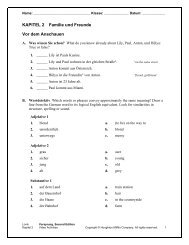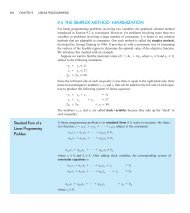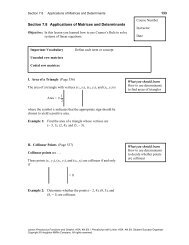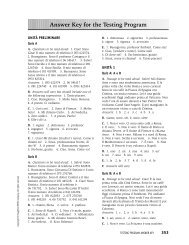9.3 THE SIMPLEX METHOD: MAXIMIZATION
9.3 THE SIMPLEX METHOD: MAXIMIZATION
9.3 THE SIMPLEX METHOD: MAXIMIZATION
Create successful ePaper yourself
Turn your PDF publications into a flip-book with our unique Google optimized e-Paper software.
496 CHAPTER 9 LINEAR PROGRAMMING<br />
The entry in the lower–right corner of the simplex tableau is the current value of z. Note<br />
that the bottom–row entries under x1 and x2 are the negatives of the coefficients of x1 and<br />
x2 in the objective function<br />
To perform an optimality check for a solution represented by a simplex tableau, we look<br />
at the entries in the bottom row of the tableau. If any of these entries are negative (as<br />
above), then the current solution is not optimal.<br />
Pivoting<br />
z 4x 1 6x 2 .<br />
Once we have set up the initial simplex tableau for a linear programming problem, the simplex<br />
method consists of checking for optimality and then, if the current solution is not optimal,<br />
improving the current solution. (An improved solution is one that has a larger z-value<br />
than the current solution.) To improve the current solution, we bring a new basic variable<br />
into the solution––we call this variable the entering variable. This implies that one of the<br />
current basic variables must leave, otherwise we would have too many variables for a basic<br />
solution––we call this variable the departing variable. We choose the entering and<br />
departing variables as follows.<br />
1. The entering variable corresponds to the smallest (the most negative) entry in the<br />
bottom row of the tableau.<br />
2. The departing variable corresponds to the smallest nonnegative ratio of biaij, in the<br />
column determined by the entering variable.<br />
3. The entry in the simplex tableau in the entering variable’s column and the departing<br />
variable’s row is called the pivot.<br />
Finally, to form the improved solution, we apply Gauss-Jordan elimination to the column<br />
that contains the pivot, as illustrated in the following example. (This process is called<br />
pivoting.)<br />
EXAMPLE 1 Pivoting to Find an Improved Solution<br />
Use the simplex method to find an improved solution for the linear programming problem<br />
represented by the following tableau.<br />
Basic<br />
x1 x2 s1 s2 s3 b Variables<br />
1 1 1 0 0 11 s1 1 1 0 1 0 27 s2 2 5 0 0 1 90 s3 4<br />
6<br />
0 0 0 0<br />
The objective function for this problem is z 4x 1 6x 2 .
















